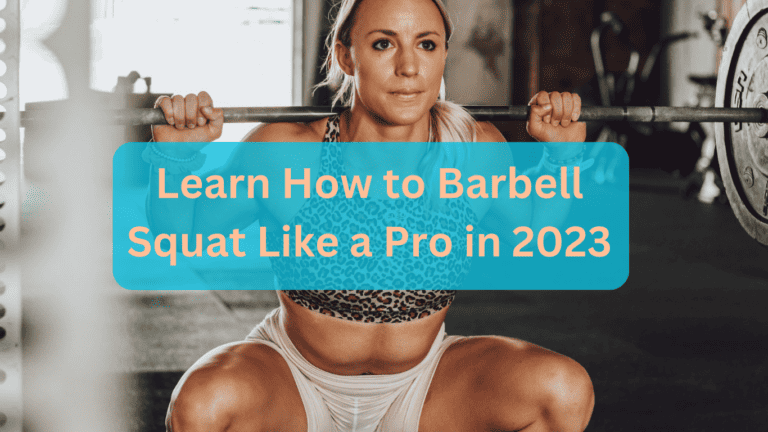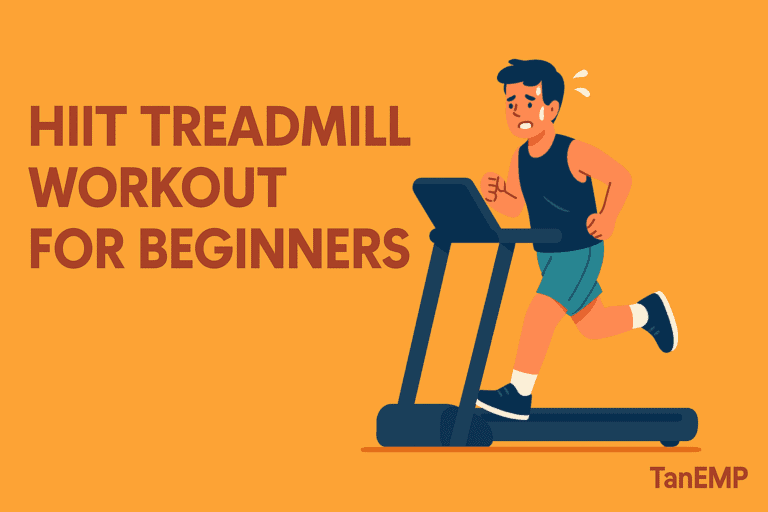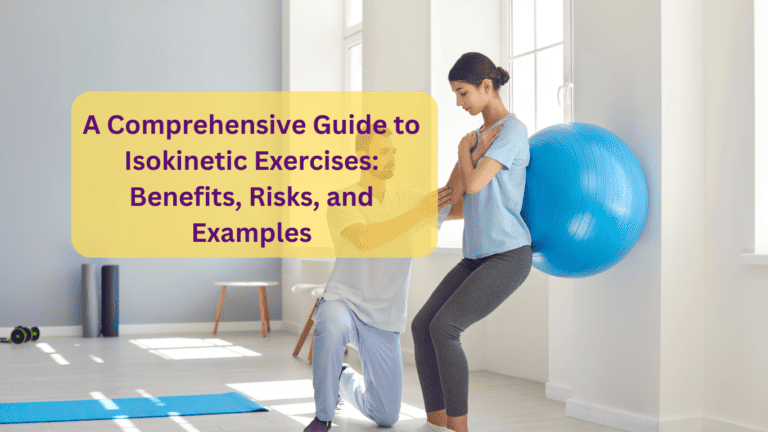9 Erector Spinae Exercises for a Strong, Pain-Free Back (+2 Bonus Tips)

Feel lower back pain after workouts? Sore from sitting too long or noticing your posture slipping mid-day?
You might think your back is just weak, but do you know which muscles are supposed to be holding you upright?
It’s likely your erector spinae muscles — a group of deep back muscles that run along either side of your spine and play a vital role in posture, movement, and stability.
They fire every time you lift, walk, hinge, or even try to sit tall. But when your glutes and hamstrings aren’t pulling their weight, your spinal erectors pick up the slack. That’s when tightness, fatigue, and poor posture start creeping in.
⚡ Key Takeaways (TL;DR)
- Your erector spinae muscles support your spine, posture, and movement.
- Weak glutes or hamstrings often force them to overwork.
- These exercises build strength across multiple muscle groups to fix the imbalance.
- Focus on form, alignment, and your full posterior chain — not just your lower back.
🏃♂️ Don’t Have Time? Start With These 3:
If you’re short on time or just starting, focus on these 3 moves to build a strong, stable back fast:
- Glute Bridge with Posterior Pelvic Tilt
Re-trains your body to activate your glutes and take pressure off your lower back. - Superman Hold
Strengthens your spinal erectors and improves posture with just bodyweight. - Bird Dog
Builds deep core and back stability for runners, lifters, and desk workers alike.
For the full list of exercises and how to do each one properly, keep reading below.
🧠 What Is the Erector Spinae — and Why Does It Matter
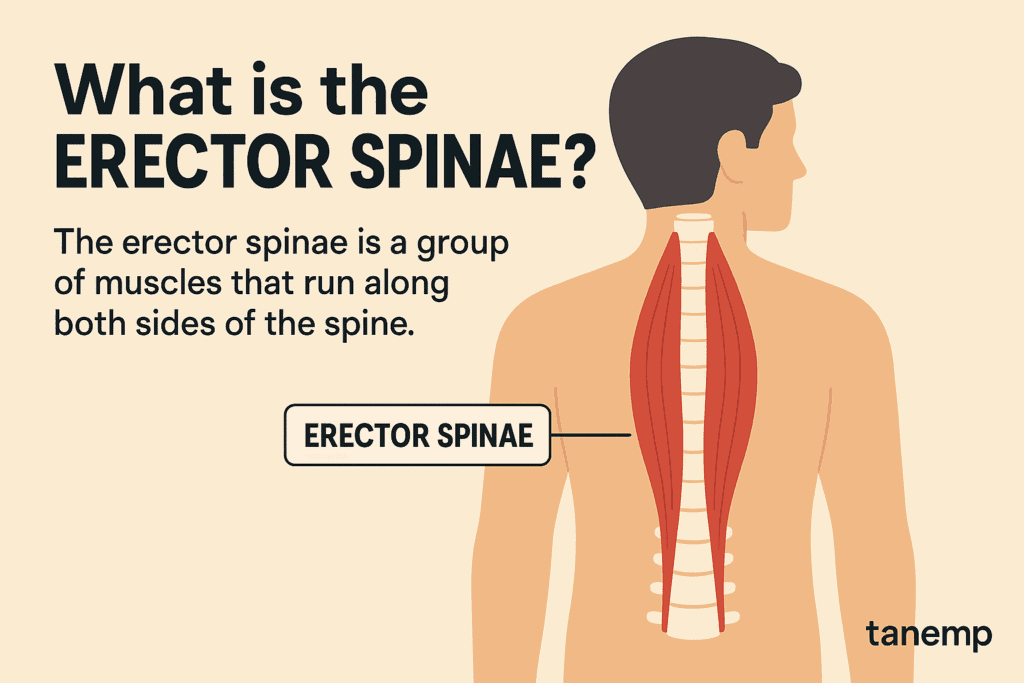
The erector spinae muscles comprise the intermediate layer of the deep (intrinsic) muscles of the back… They work constantly to keep you upright.
Want to dive deeper into the anatomy? Kenhub offers a great visual guide to the erector spinae muscles.
You won’t see them in the mirror, but they’re working constantly to keep you upright.
Whenever you:
- Sit or stand tall
- Hinge at the hips
- Carry a bag of groceries
- Or finish a long walk without slouching…
…your erector spinae muscles are behind the scenes doing the work.
They’re part of your posterior chain, and even though they’re often overlooked in workouts, they’re just as important as your glutes or core muscles when it comes to staying balanced and injury-free.
You don’t need to memorize anatomy here — just know these muscles help support your entire spine and give your body the postural control it needs.
💪 Why Strengthening the Erector Spinae Helps
This is well-placed, but the flow could be tightened slightly to match your blog’s natural, beginner-friendly tone — and make the Cleveland Clinic link stand out more clearly.
Here’s a polished version:
💪 Why Strengthening the Erector Spinae Helps
Back pain is one of the most common complaints, but it’s not always caused by tight muscles — weakness plays a big role.
The Cleveland Clinic explains how a strong back supports your spine and helps prevent pain. It’s not just about stretching — it’s about support.
For example:
People who sit all day often stretch their hips constantly but still feel stiff. That’s because one muscle (like the psoas) might be tight, but another (like your spinal erectors) is weak.
You can stretch your QL all day, but if your erector spinae muscles aren’t doing their job, your spine won’t feel supported — and that tension keeps coming back.
When your glutes, hamstrings, or deep core muscles don’t hold their share of the load, your back picks up the slack. That leads to fatigue, poor posture, and even shoulder tension.
Training strong erector spinae muscles helps fix that. It supports your spine, balances your upper body, and builds better control when lifting, running, or just standing tall.
🔥 11 Best Erector Spinae Exercises
Now that you know why the erector spinae matters, let’s get into the good stuff.
These are our favorite exercises to help you build a stronger, more stable spine, without overcomplicating things. Some use just your bodyweight, others need a band or a simple machine.
Start slow, focus on form, and get ready to feel the difference.
1. Bird Dog
The bird dog is one of the best erector spinae exercises for beginners. It’s a simple bodyweight exercise that targets your core muscles, glutes, and spinal erectors, while training your body to move with control and balance.
It’s also great for improving posture and coordination across your upper body and hips, making it a go-to for anyone dealing with poor posture or lower back tightness.

How to Do It:
- Begin in a tabletop position with your hands and knees on the ground, shoulder width apart.
- Tighten your core. Slowly extend your right arm and left leg into a straight line, keeping your hips level.
- Pause at the top, then return to the starting position.
- Switch sides and repeat for 6–10 reps per side, focusing on proper form.
Tip: Keep your movement slow and controlled. Avoid twisting your torso or shifting weight — your spine should stay in a neutral position, not arching or dipping.
Runner’s Note: This is one of the best exercises to improve postural stability during long runs or trail sections where balance and spinal control are key.
2. Superman Hold
Superman is a classic erector spinae exercise that strengthens the back of your body, especially your erector spinae muscles, glutes, and shoulders. It’s a great way to build awareness and control in your spinal erectors, especially if you tend to sit or slouch throughout the day.
This move mimics a flying position — but don’t worry, no cape required.

How to Do It:
- Lie face down on a mat with your arms extended overhead and legs straight.
- Brace your core and lift your chest, arms, and legs off the ground into a superman position.
- Hold for 3–5 seconds, then slowly lower back down to the ground with control.
- Repeat 8–12 reps for 2–3 sets.
Tip: Don’t overextend your neck or swing your limbs. Keep your gaze down, move in smooth and slow motion, and focus on squeezing your glutes and upper back.
Runner’s Note: This exercise helps counteract rounded shoulders and builds endurance through your posterior chain — ideal for maintaining better posture during long-distance runs.
3. Glute Bridge March
This variation of the glute bridge adds a challenge to your balance and stability, activating your glutes, core muscles, and erector spinae muscles in one smooth motion. It’s a great bodyweight exercise for building spinal control and teaching your hips to move independently without letting your lumbar spine take over.
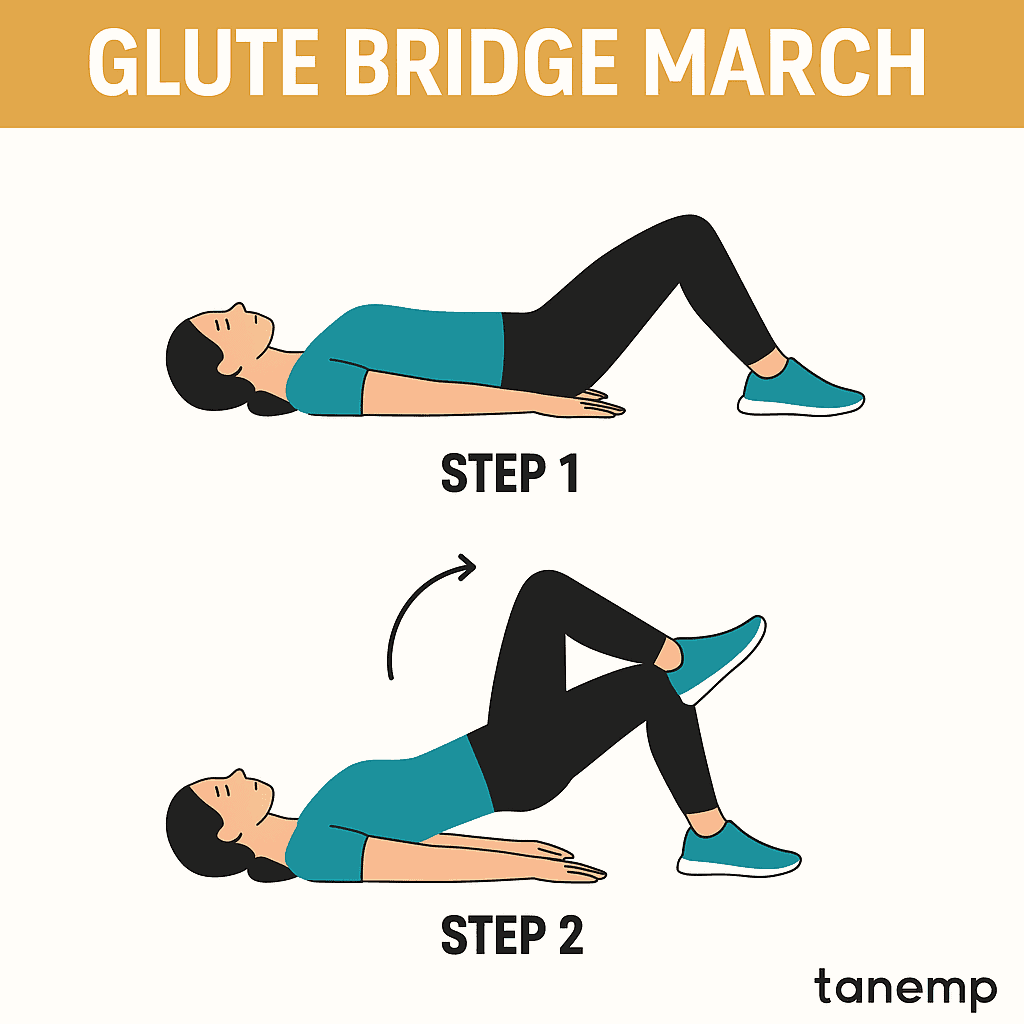
How to Do It:
- Lie face up on the floor with your feet hip-width apart, knees bent, and arms at your sides.
- Press through your heels and lift your hips into a straight line from shoulders to knees — squeezing your glutes at the top.
- Keeping your hips level, slowly lift one foot off the ground like a slow march.
- Pause, then lower it back down and repeat on the other side.
- Continue alternating legs for 6–10 total reps, keeping your entire spine stable.
Tip: Before lifting, focus on a posterior pelvic tilt — tuck your pelvis under slightly and drive your hips forward. This helps fire your glutes and reduce strain on your lower back.
4. Good Morning
The good morning is one of the most effective compound exercises for building strength across your posterior chain, including your erector spinae, glutes, hamstrings, and core muscles.
It trains your body to hinge forward at the hips with control while keeping a neutral position through your spine, which translates directly to better mechanics in squats, deadlifts, and daily movement.

How to Do It:
- Stand straight with your feet shoulder-width apart and place your hands behind your head.
- Brace your core and bend forward at the hips, keeping your back flat and knees slightly bent.
- Lower your torso until it’s nearly parallel to the floor, then return to the upright position by driving through your hips.
- Repeat 8–10 reps with proper form.
Tip: Think about reaching your hips back behind you, not just folding forward. Keep your spine long, your chest open, and avoid rounding your shoulders.
5. Prone Back Extension
The prone back extension is a simple but powerful isolation exercise that targets your erector spinae muscles directly. It helps strengthen the support system around your lumbar spine, which is essential for maintaining better posture and protecting against strain or fatigue.
This is one of the more beginner-friendly erector spinae exercises and requires no equipment — just your body and a little floor space.

How to Do It:
- Lie face down on a mat with your arms extended forward and your legs straight.
- Squeeze your glutes and slowly lift your upper body off the ground using your spinal erectors — not by yanking with your arms or neck.
- Pause at the top while keeping your chest open and spine long.
- Slowly lower back down with control.
- Perform 10–12 reps for 2–3 sets.
Tip: Keep your gaze down and don’t overextend your back. Focus on using your back muscles and breathing through each rep. Your goal is control, not height.
6. Back Extension Machine
The back extension machine is a gym staple for building strong erector spinae muscles. When used with proper form, it’s one of the most effective spinae exercises for strengthening your lumbar spine and reducing the risk of back injury.
This move targets your erector spinae muscles directly, while encouraging control through your shoulder blades and hips, making it ideal for those looking to improve strength and maintain good posture under load.
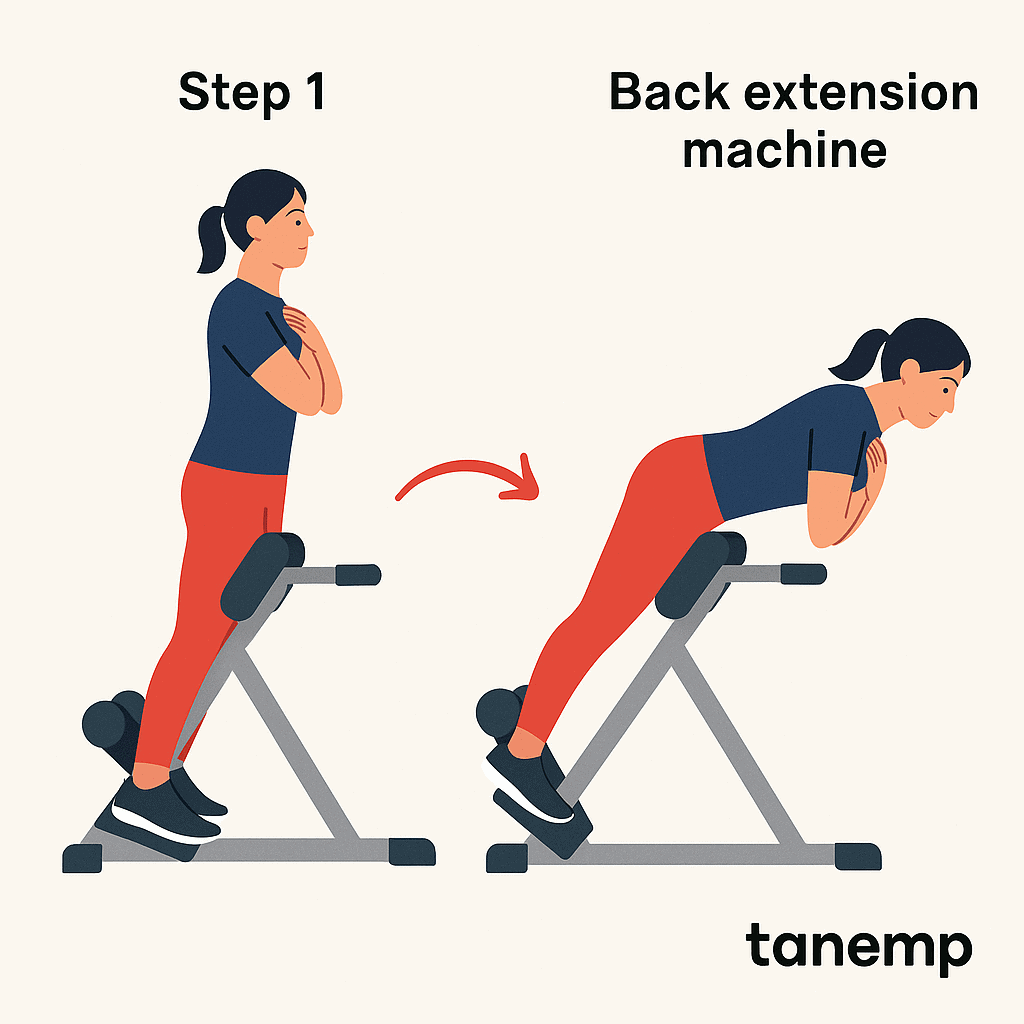
How to Do It:
- Adjust the extension machine so the pad sits just below your hips. Your upper body should move freely without restriction.
- Cross your arms or place your hands on your chest. Keep your shoulder blades pulled back.
- Hinge at your hips to lower your torso slowly, then reverse the motion to lift your chest until your spine is in line, not hyperextended.
- Pause briefly at the top, then lower with control.
- Perform 8–10 reps for 2–3 sets.
Tip: Focus on squeezing your glutes and controlling your descent. Don’t swing through the movement. This isn’t about momentum — it’s about building strength and resilience through your back muscles and spine.
7. Stiff-Leg Deadlift
The stiff-leg deadlift is a powerful compound exercise that targets your erector spinae muscles, hamstrings, and glutes. By keeping your legs straight (with a slight knee bend), you increase the stretch on your posterior chain, especially the back muscles and hamstrings.
This movement teaches you how to hinge forward correctly and maintain tension from your hips through your entire spine, building control in both your glutes and spinal stabilizers.

How to Do It:
- Stand tall with a barbell or dumbbells in front of your thighs, arms relaxed, shoulder width apart.
- Keep your knees slightly bent and hinge forward at the hips, lowering the weight slowly down your legs.
- Maintain a neutral spine — don’t round your back.
- Pause when you feel a deep hamstring stretch, then drive your hips forward to return to standing.
Tip: Keep your shoulders pulled back and your back flat throughout. Focus on control, not depth — if your back rounds, you’ve gone too far.
8. Rack Pulls
Rack pulls look like deadlifts, but with a twist: the bar starts at about knee height on a rack or blocks. This shorter range of motion puts less stress on the hamstrings and more focus on your erector spinae, spinal erectors, and upper back.
Because you’re lifting from a higher position, you can usually pull more weight, making it a great move for building good posture and teaching your spine to stay upright under load.

How to Do It:
- Set a loaded barbell on the safety pins of a rack just below your knees.
- Stand with your feet shoulder-width apart and grip the bar with your hands shoulder-width apart.
- Brace your core, tighten your lats, and pull the bar straight up to a tall upright position.
- Lower slowly and repeat for 4–8 reps.
Tip: Keep your spine stacked and your chest proud. Think of this more as a posture drill than a full lift. Focus on squeezing your shoulder blades together as you finish each rep.
9. Resistance Band Row
The resistance band row is a fantastic bodyweight exercise that targets the upper body, particularly the back muscles, shoulder blades, and arm muscles, all with minimal equipment. It’s beginner-friendly and can be performed at home, making it a practical addition to your erector spinae exercises routine.
Rows help strengthen the muscles responsible for pulling your shoulders back, which helps reduce rounded shoulders and improve posture.
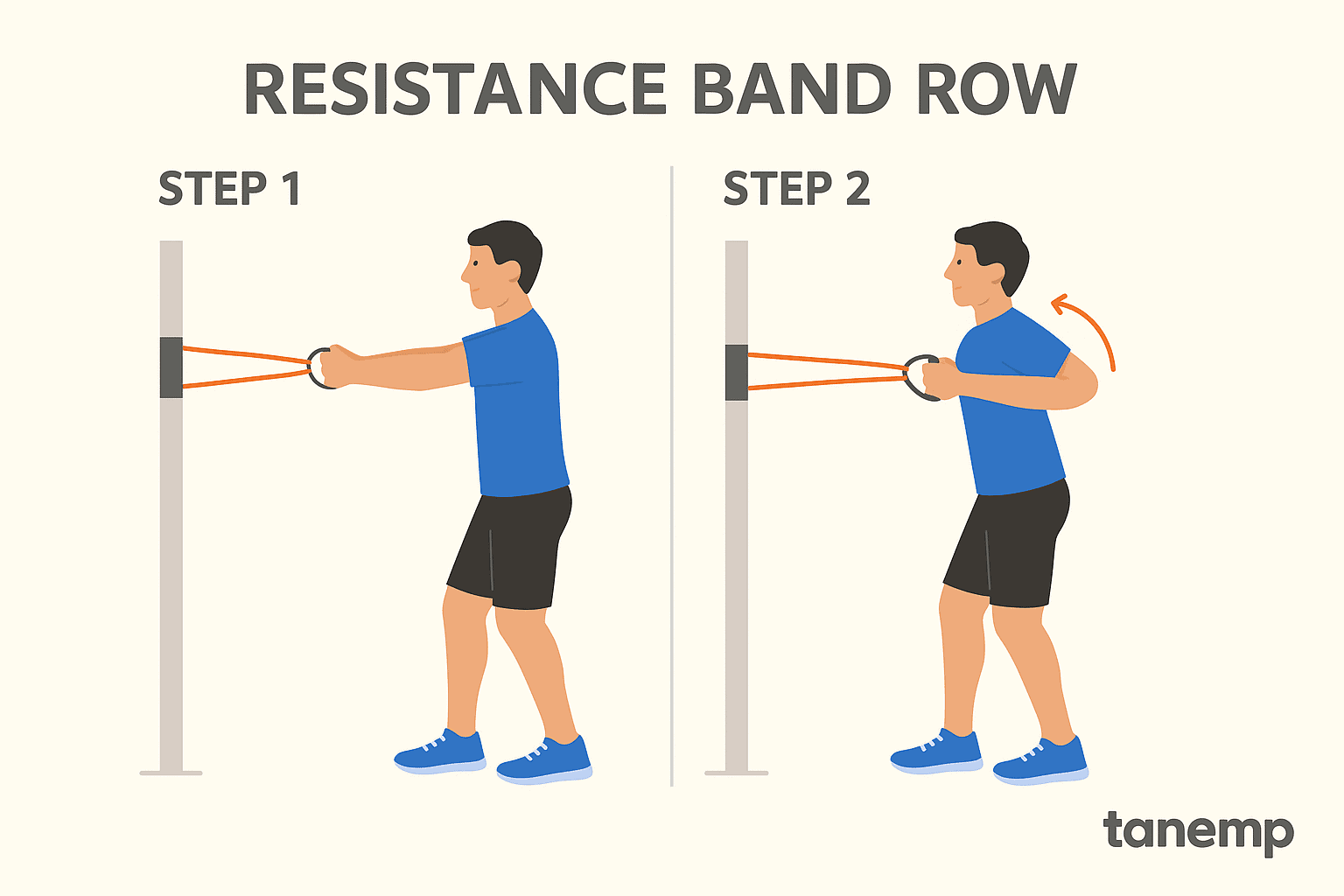
How to Do It:
- Anchor a resistance band at chest height (around a pole or door).
- Grab the handles and step back until there’s tension in the band.
- Start in a staggered stance with your feet shoulder-width apart, arms extended, and your core braced.
- Pull the handles toward your ribs by squeezing your shoulder blades together.
- Pause briefly, then slowly return to your starting position.
Tip: Focus on control. Keep your shoulders relaxed and your elbows tight to your body. This isn’t just a pull — it’s a posture reset.
🔁 Bonus 1: Glute Bridge with Posterior Pelvic Tilt
This isn’t your average glute bridge.
By adding posterior pelvic tilt to the movement, you shift the effort away from your erector spinae muscles and toward your glutes, hamstrings, and deep core muscles — the ones that often get ignored when people compensate with their lower back.
If your spinal erectors are overactive or you’re coming back from poor posture habits, this controlled version is a must.
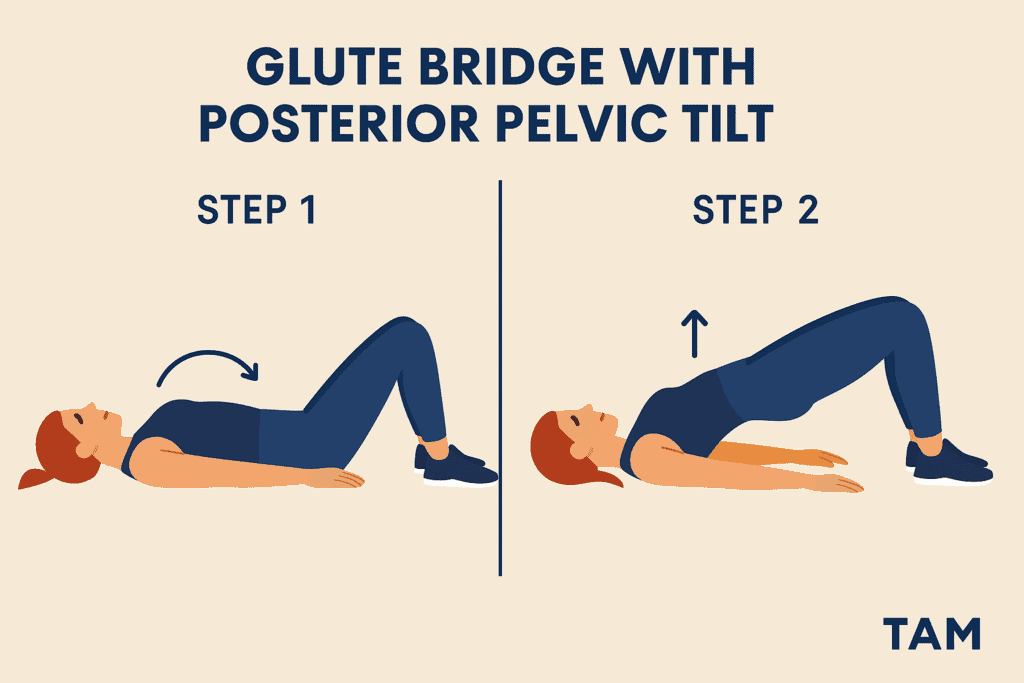
How to Do It:
- Lie on your back with your knees bent, feet flat, and arms by your sides. Start in a neutral position.
- Slowly tuck your pelvis so your lower back presses gently into the floor — this is the posterior pelvic tilt.
- Hold this tilt, then squeeze your glutes and lift your hips without arching your back.
- Pause at the top when your knees, hips, and shoulders form a straight line.
- Lower with control and repeat.
Tip: Having trouble activating your glutes? Try this mind-body cue:
- Press your feet into the floor.
- Tighten your calves, then your hamstrings, then your glutes.
- Hold the tilt and drive your hips up in one smooth motion.
This “sequential squeeze” helps wake up the entire posterior chain without letting your back take over.
Why It Matters: Weak glutes = overworked back. This variation teaches your body to offload your spine by re-engaging the muscles that should be doing the work, helping reduce pain and build better posture over time.
🔁 Bonus 2 (Advanced): Ab Wheel Rollout
If you’re looking to take your core and spinal stability to the next level, the ab wheel rollout is one of the best advanced erector spinae exercises you can add.
Though it’s mostly known as an ab move, the rollout also trains your erector spinae muscles to resist collapse and overextension, especially during the reach phase. It builds deep control across your entire spine, helping you stay strong and aligned through long runs, lifts, or overhead movements.
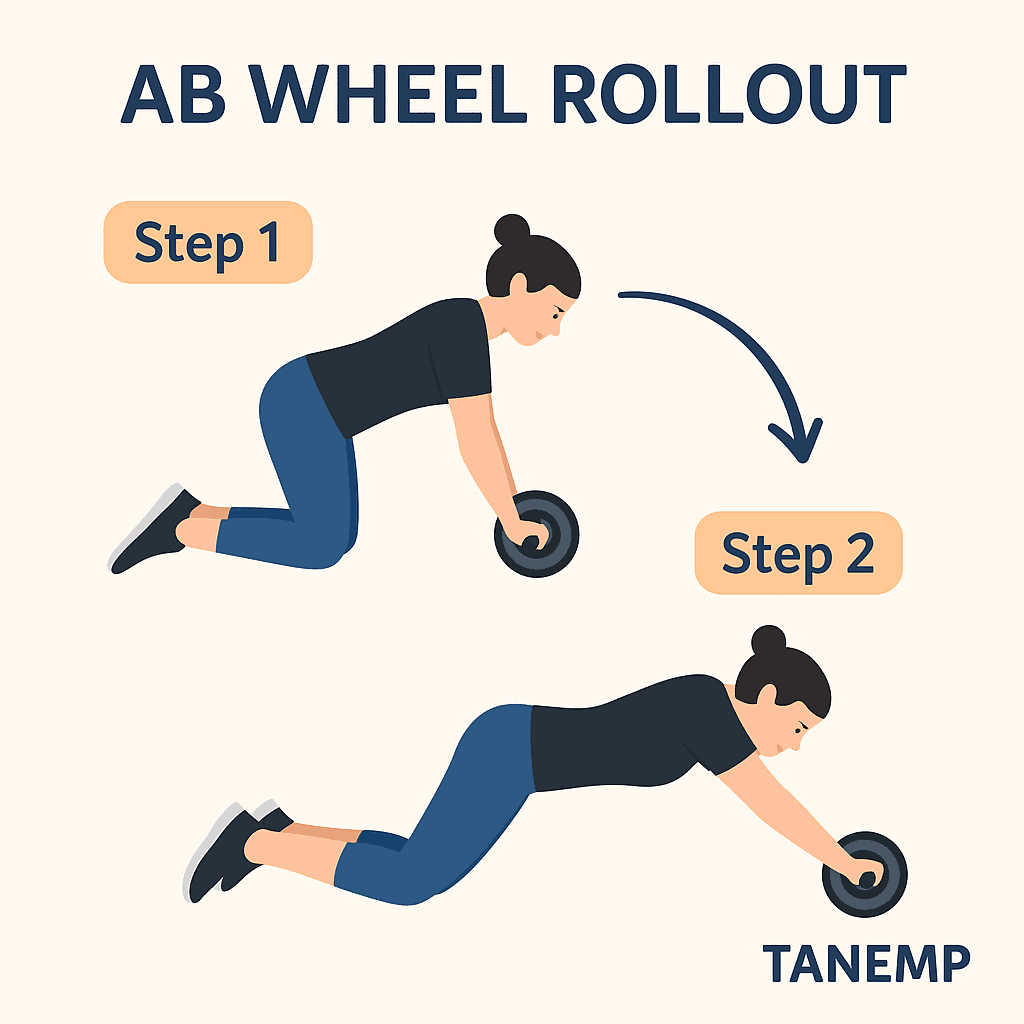
How to Do It:
- Start in a kneeling position with the ab wheel on the floor in front of you, arms fully extended.
- Slowly roll the wheel forward, keeping your hips tucked and spine neutral. Don’t let your back arch.
- Roll out as far as you can control, then pause.
- Pull back using your core and lats to return to the starting position.
Tip: Only go as far as you can maintain tension without letting your hips sag or your lower back arch. This is a slow, control-based movement, not about distance or speed.
Why It Works: This move forces your spinal erectors, abs, and deep core muscles to work together to prevent your spine from folding, making it a smart addition to any full-body strength plan.
🧠 Tips for Better Results
Getting stronger isn’t just about the exercise — it’s how you train and recover that builds real progress.
- Move with control
Focus on smooth and slow motion for better results and less strain. - Train consistently, not excessively
Aim for 2–3 focused sessions each week to strengthen your erector spinae muscles without overload. - Combine isolation + compound
Use both isolation exercises (like bird dog) and compound exercises (like rack pulls) to train multiple muscle groups. - Support your posture
Reset your shoulder blades, keep a neutral spine, and avoid rounded shoulders during every rep. - Keep your core on
Your core muscles stabilize everything. Engage them even in upper or lower body moves. - Recovery matters
Soreness is normal. Neglecting recovery? That’s when things break down. Hydrate, stretch, and consider foam rolling.
📅 Training Plan & Recovery Tips
What to Focus On | Recommendation |
|---|---|
Frequency | 2–3x per week |
Reps | 8–15 reps per set |
Rest Between Sets | 30–60 seconds |
Recovery Tools | Stretching, hydration, and foam rolling |
Extra Tip | Don’t train through pain — train smart |
✅ Wrap-Up
Your erector spinae muscles do more than support your back — they’re a key part of your posture, performance, and injury prevention system.
Whether you’re cross-training, running, recovering from soreness, or just trying to move better, adding 2–3 of these exercises to your weekly routine can make a real difference.
Don’t try all 10 at once — start small, focus on form, and build up over time.
Stay consistent. Train smart. And let your strength build naturally.
Want more tips on recovery and movement? Explore TanEMP’s full blog for expert-backed advice on strength, posture, and injury prevention.
- Speed up muscle strain recovery
- Try this 5-minute running warm-up
- Dynamic vs static stretching explained
Disclaimer: This article is based on my experience as a licensed chiropractor and recreational runner. The information provided is for educational and informational purposes only and is not intended to replace medical advice, diagnosis, or treatment. Always consult with your healthcare provider before beginning a new exercise program, especially if you have pain, injuries, or medical concerns.
❓ FAQ: Erector Spinae Exercises
What are the best erector spinae exercises for beginners?
Start with bird dog, superman, and glute bridges. These low-impact bodyweight exercises train your spinal erectors while improving core muscle control and posture.
How often should I train my erector spinae muscles?
2–3 times per week is enough for most people. Focus on proper form, allow for recovery, and avoid pushing through pain.
Can weak erector spinae muscles cause back pain?
Yes. Weakness in these muscles can lead to poor posture, fatigue during standing or lifting, and strain in the lumbar spine. Strengthening them supports your entire vertebral column.
Do I need gym equipment?
Not necessarily. Many erector spinae exercises can be done with just your body weight. But using a back extension machine, resistance bands, or a loaded barbell adds intensity as you progress.
How do I know if I’m using proper form?
Start in a neutral spine, keep your shoulder blades pulled back, and avoid rounded shoulders. Move with control, not momentum. If unsure, record yourself or ask a coach.
